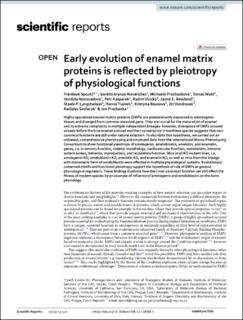Early evolution of enamel matrix proteins is reflected by pleiotropy of physiological functions
| dc.contributor.author | Spoutil, Frantisek | |
| dc.contributor.author | Aranaz-Novaliches, Goretti | |
| dc.contributor.author | Prochazkova, Michaela | |
| dc.contributor.author | Wald, Tomas | |
| dc.contributor.author | Novosadova, Vendula | |
| dc.contributor.author | Kasparek, Petr | |
| dc.contributor.author | Osicka, Radim | |
| dc.contributor.author | Reseland, Janne Elin | |
| dc.contributor.author | Lyngstadaas, Ståle Petter | |
| dc.contributor.author | Tiainen, Hanna | |
| dc.contributor.author | Bousova, Kristyna | |
| dc.contributor.author | Vondrasek, Jiri | |
| dc.contributor.author | Sedlacek, Radislav | |
| dc.contributor.author | Prochazka, Jan | |
| dc.date.accessioned | 2023-04-14T13:29:34Z | |
| dc.date.available | 2023-04-14T13:29:34Z | |
| dc.date.created | 2023-04-13T13:55:15Z | |
| dc.date.issued | 2023 | |
| dc.identifier.issn | 2045-2322 | |
| dc.identifier.uri | https://hdl.handle.net/11250/3063172 | |
| dc.description.abstract | Highly specialized enamel matrix proteins (EMPs) are predominantly expressed in odontogenic tissues and diverged from common ancestral gene. They are crucial for the maturation of enamel and its extreme complexity in multiple independent lineages. However, divergence of EMPs occured already before the true enamel evolved and their conservancy in toothless species suggests that non-canonical functions are still under natural selection. To elucidate this hypothesis, we carried out an unbiased, comprehensive phenotyping and employed data from the International Mouse Phenotyping Consortium to show functional pleiotropy of amelogenin, ameloblastin, amelotin, and enamelin, genes, i.e. in sensory function, skeletal morphology, cardiovascular function, metabolism, immune system screen, behavior, reproduction, and respiratory function. Mice in all KO mutant lines, i.e. amelogenin KO, ameloblastin KO, amelotin KO, and enamelin KO, as well as mice from the lineage with monomeric form of ameloblastin were affected in multiple physiological systems. Evolutionary conserved motifs and functional pleiotropy support the hypothesis of role of EMPs as general physiological regulators. These findings illustrate how their non-canonical function can still effect the fitness of modern species by an example of influence of amelogenin and ameloblastin on the bone physiology. | en_US |
| dc.language.iso | eng | en_US |
| dc.publisher | Nature | en_US |
| dc.rights | Navngivelse 4.0 Internasjonal | * |
| dc.rights.uri | http://creativecommons.org/licenses/by/4.0/deed.no | * |
| dc.title | Early evolution of enamel matrix proteins is reflected by pleiotropy of physiological functions | en_US |
| dc.title.alternative | Early evolution of enamel matrix proteins is reflected by pleiotropy of physiological functions | en_US |
| dc.type | Peer reviewed | en_US |
| dc.type | Journal article | en_US |
| dc.description.version | publishedVersion | en_US |
| dc.source.volume | 13 | en_US |
| dc.source.journal | Scientific Reports | en_US |
| dc.source.issue | 1 | en_US |
| dc.identifier.doi | 10.1038/s41598-023-28388-4 | |
| dc.identifier.cristin | 2140613 | |
| cristin.ispublished | true | |
| cristin.fulltext | original | |
| cristin.qualitycode | 1 |

